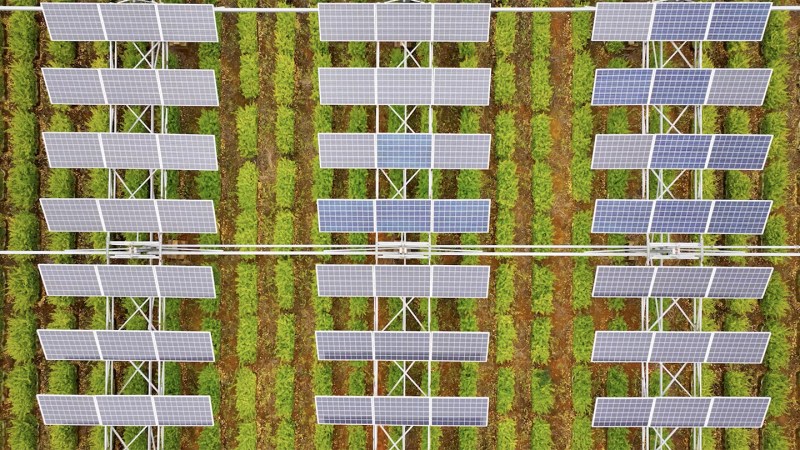
Extreme Climate Survey
Scientific news is collecting questions from readers about how to navigate our planet’s changing climate.
What do you want to know about extreme heat and how it can lead to extreme weather events?
McCall: Argivoltaics is a term for the co-location of solar and agricultural activities, such as grazing, crop production and also ecological restoration.
Sujith: Argivoltaics has numerous benefits, both for farmers and solar developers.
McCall: If solar developers can show that they are using the land to the highest benefit, then they can use more land to develop more solar power. And then the next big one is the farmer and the land owner himself.
Sujith: Even if you lease your land for solar development, you may still have an income-generating activity such as growing crops or grazing sheep.
McCall: There are also local communities that can benefit from this. It could potentially create pollinator habitat or prairie restoration.
Seok-Choi: It used to be common practice for people to leave the ground bare for building solar, but that’s no longer the case.
Sujith: By covering the soil with vegetation, they can avoid erosion and use it as an opportunity to restore soil carbon.
McCall: Currently in the United States, there are approximately 530 (as of July 2024) argiovoltaic sites. It’s a roughly fifty-fifty split between pollinator habitats and solar grazing.
Seok-Choi: Right now, there’s a lot of focus on letting sheep graze under solar panels because they don’t jump on the panels, they don’t like to chew wires or anything.
Sujith: Integrating sheep grazing can also improve soil nutrients. So we just completed a five-year study in the middle US. Many of these areas have high carbon depletion due to intensive agriculture. And we actually found that managed sheep grazing can actually improve old soil carbon and nutrients.
McCall: And so, if it’s still the same cost as mowing the grass and we can provide a benefit to both the local grazers and potentially the environment, why not make it part of their standard practice somehow.
Sujith: So overall, there’s sort of an emerging consensus that solar grazing has some value in many of these landscapes. However, there are many unknowns when it comes to plant production.
McCall: Of those 570 argiovoltaic countries, only 40 are really focused on crop production. And a lot of those places are these small-scale research places.
Sujith: So the first thing to consider is which crops are best in which climates or geographical locations? This is a critical question because some crops can do well in shade, while some crops have significant yield losses in shade.
McCall: So even two varieties of the same tomato can respond very differently to the type of microclimate actually created by the solar panels. And then the weather patterns are not constant every year. So it’s very difficult to make some generalizations about the kind of when and where crops would be available.
Seok-Choi: But in addition, crop production requires many modifications in engineering and design.
McCall: We actually have to raise the panels high enough so they don’t get shaded or we have to spread the panels much farther apart to actually get traditional farming equipment. Basically, all the changes that need to happen come with a cost trade-off or you’re getting less power. That’s why we’re seeing a little more hesitation in the US market.
McCall: We’re not going to do every system design everywhere, but where and when does it make sense and why would the various stakeholders want to do it? As we see climate change such as reduced access to water and rising temperatures, there will be a need for solar integration. A prime example of this is wine grape production in California, where temperatures are currently too hot to actually produce certain grape varieties. And so they have to implement shadow structures. And so why not also produce solar power and make some money from that shade structure.
McCall: Eh, there’s also this broader need to grow food much closer to population centers.
Sujith: So, currently we are trying to understand which configurations of argivoltaic systems are suitable for our urban areas. We’ve set up an experimental system at Temple University’s Ambler Campus, which could fit in an abandoned parking lot or something else in a city. So the idea is to compare, like the solar groups that are affecting these cultures in different ways. It can actually improve yields of leafy greens. So we might be able to produce one more cycle of lettuce. But we still need to expand the study to other areas to see how the impacts are different. The next 10 years will provide a lot of information on different types of integration. This can be applied in different parts of the world.
Seok-Choi: And this is my dream. Where we can show a map and say, if we put panels here, the climate would be changed in such a way that we could grow this crop.
McCall: So this is not a one panacea solution that fits all. It really requires some thought. It really takes a lot of different stakeholders to get their perspective out there. But more solar production can also help meet climate change goals, and so it’s a matter of urgency to ensure we use this land to its highest benefit.
#solar #farms #agricultural #farms #coexist
Image Source : www.sciencenews.org